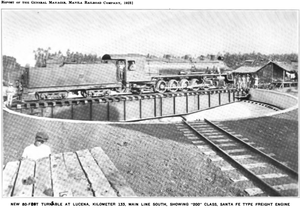User:Hachijo8/MR200
| Manila Railroad 200 class | |||||||||||||||||||||||||||||||||||||||||||||||||||||
|---|---|---|---|---|---|---|---|---|---|---|---|---|---|---|---|---|---|---|---|---|---|---|---|---|---|---|---|---|---|---|---|---|---|---|---|---|---|---|---|---|---|---|---|---|---|---|---|---|---|---|---|---|---|
 A 200 class in Lucena in 1922. It was then the terminus of the South Main Line until the extension to Albay was opened in 1938. | |||||||||||||||||||||||||||||||||||||||||||||||||||||
| |||||||||||||||||||||||||||||||||||||||||||||||||||||
| |||||||||||||||||||||||||||||||||||||||||||||||||||||
| |||||||||||||||||||||||||||||||||||||||||||||||||||||
| |||||||||||||||||||||||||||||||||||||||||||||||||||||
| References:[2][3] | |||||||||||||||||||||||||||||||||||||||||||||||||||||
The Manila Railroad 200 class were 2-10-2 Santa Fe steam locomotives operated by the Manila Railroad Company (MRR), predecessor of the Philippine National Railways.[2] They were built alongside the 4-8-2 170-class by the American Locomotive Company at its Brooks facility between 1921 and 1922. During its service at the MRR, it carried heavy freight trains on the South Main Line between Manila and the Bicol Region.[4]
Unlike the 170 class, all 10 locomotives were destroyed during World War II. These locomotives were ultimately scrapped without a single unit preserved like all of the Manila Railroad's tender locomotives.[5]
Background[edit]
The Spanish Ferrocarril de Manila–Dagupan and the British-owned Manila Railway Company Ltd. owned various tank locomotives as the bulk of its mainline fleet. In 1906, the Manila Railway purchased five 100-class locomotives. These 4-4-2 Atlantics would be the first tender locomotive in Philippine service but the company continued to acquire tank locomotives. By 1916, the Manila Railway was reorganized into the Manila Railroad Company of New Jersey.[6] Under the new American leadership, the MRR purchased heavier locomotives such as the 4-6-0 D-class built by H.K. Porter, Inc. between 1919 and 1921.
In 1921, the company ordered 20 units of heavy locomotives from the American Locomotive Company. While having similar specifications, it was grouped into two wheel configurations. Ten of these would be in a 2-10-2 Santa Fe configuration for freight and another ten would be in a 4-8-2 Mountain configuration for passenger use. The Mountain-types would become the 170-class while the Santa Fe-types would become the 200-class.
Design[edit]
The 200 class was the largest and heaviest locomotive class that entered Philippine service. With a four-axle tender, a 200 class was 80 ft (24 m) long and weighed 305,500 pounds (138,600 kg; 138.6 t).[4] Each locomotive was 50 percent heavier and twice longer than the 2-6-0+0-6-2 Kitson Meyer locomotives it replaced. Despite being its flagship class, the 200 class was still one of the smallest tender locomotives of this wheel arrangement. Santa Fes in other national railroads such as the USRA Light Santa Fe easily weighed above 100 metric tons (220,000 lb) without a tender and would rather not fit on the turntables built by the Manila Railroad.
According to Alco, it was built with almost the same exact specifications as the Mountain-type 170 class, except it had a different was heavier by 3,000 pounds (1,400 kg; 1.4 t). It also had the biggest cylinders of any non-articulated locomotive of the era that ran on narrow-gauge lines. It was not until 1927 when the so-called Henschel Giants of the South African Railways featured a wider cylinder. However, it had relatively small boilers and grates compared to the other Santa Fes, which would then contribute to its smaller size and weight.[3]
The locomotives were fitted with a Walschaerts valve gear.[3] This type has been widely used among steam locomotives in Asia.
Service[edit]
These locomotives were used on freight services on the South Main Line. Initially the line ended near Lucena, Quezon. Due to the size of the locomotives, new 80 ft (24 m) railway turntables were constructed to accommodate them.[4] The locomotives would see extended freight service to Bicol with the opening of the Lucena–Port Ragay section in 1938. In 1942, the Japanese government took control of the operations of the Manila Railroad Company in the Philippines.[7] The class did not survive World War II unlike its sister 170 class, which lasted until 1956. These were ultimately scrapped.[5]
References[edit]
- ^ DeGolyer, 1928
- ^ a b Snowden Bell, J. (March 1922). "New Mountain Type and Santa Fe Type Locomotives for the Manila Railroad". Railway and Locomotive Engineering. New York City. Retrieved October 2, 2020.
- ^ a b c Llanso, Steve. "Manila Railroad 2-10-2 Locomotives in Philippines". Sweat House Media. Retrieved October 2, 2020.
- ^ a b c Paez, Jose (December 31, 1922). "1923 Report of the General Manager". Reports of the General Manager, Manila Railroad Company.
- ^ a b "Manila RR 'Santa Fe' Locomotive 2-10-2 - 1922". Flickr. Retrieved March 16, 2020.
- ^ "Chapter I: Present Conditions". Report of Survey of the Manila Railroad Company and the Preliminary Survey of Railroads for Mindanao (Report). Chicago: De Leuw, Cather & Company. 1951. pp. 1–12.
- ^ "1942 0619 Affairs Concerning Railway Battalion of the Imperial Japanese Forces". Flickr. January 8, 2014. Retrieved March 11, 2020.
